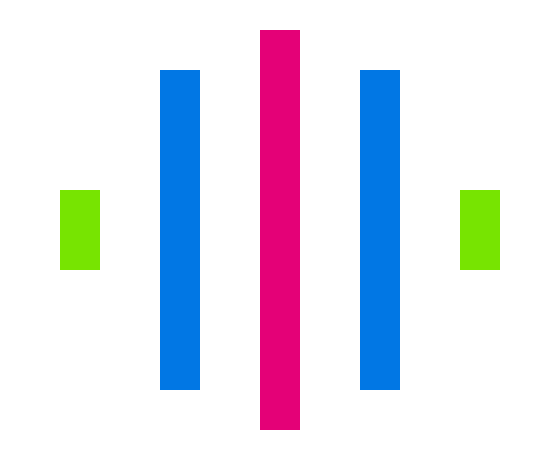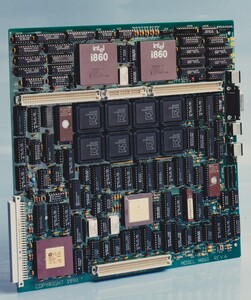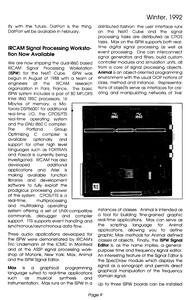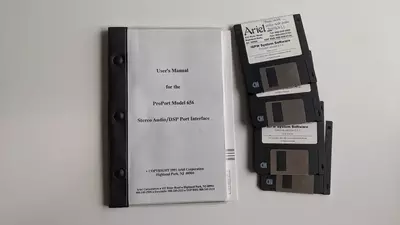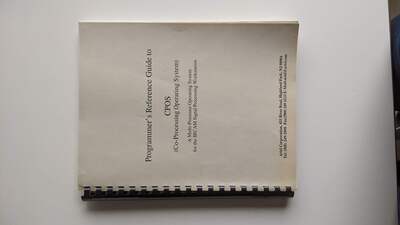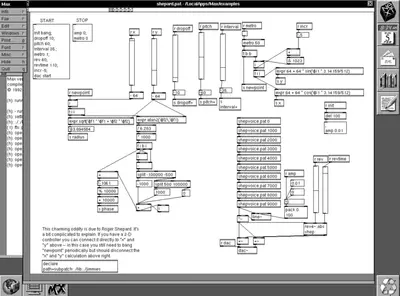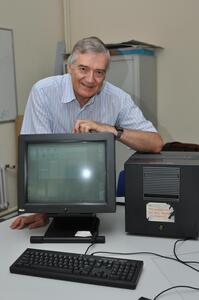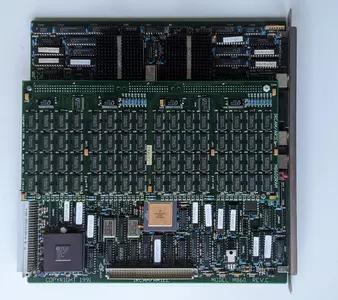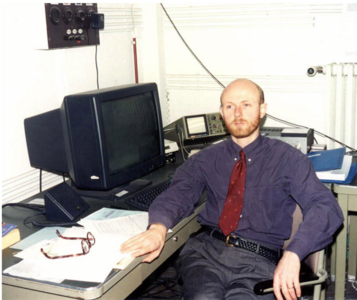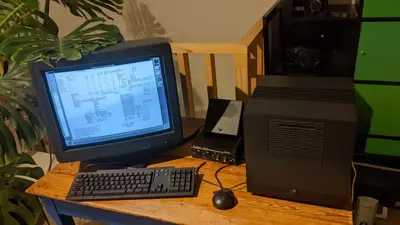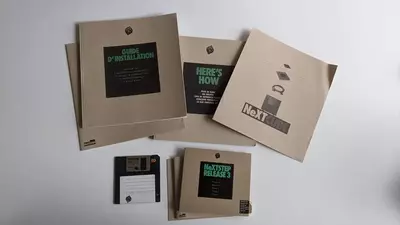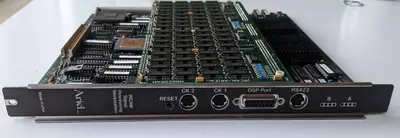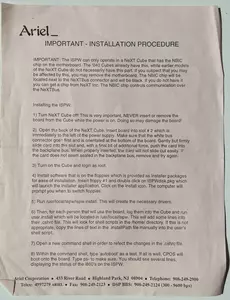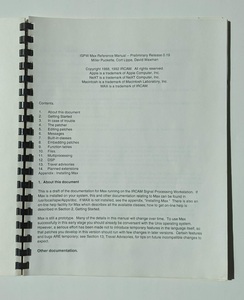~ Electronic Music and the NeXTcube - Running MAX on the IRCAM Musical Workstation
» By Joren on Tuesday 02 May 2023The NeXTcube is an influential machine in computing history. The NeXTcube, with an additional soundcard, was also one of the first off-the-shelf devices for high-quality, real-time music applications. I have restored a NeXTcube to run an early version of MAX, an environment for interactive music applications.
The NeXTcube context and the IRCAM Musical Workstation
In 1990 NeXT started selling the NeXTcube, a high-end workstation. It introduced or brought together many concepts (objective-c, the Mach kernel, postscript, an app store) which are still in use today. The NeXTcube’s influence is especially felt in the Apple ecosystem with Mac OS X, iPhones and iPads being direct decedents of NeXT’s line of computers.
Due to its high price, the NeXTcube was not a commercial success. It mainly ended up at companies or in the hands of researchers. Two of those researchers, Tim Berners-Lee and Robert Cailliau created the first http server and web browser at CERN on a NeXTcube. Coincidently, the http software was publicly released exactly 30 years ago today. Famously, the cube was also used to develop games like the original Doom and Quake. So yes, the NeXTcube runs Doom.

Fig: the NeXTcube's design stood out compared to the contemporary beige box PCs.
Less well known is the fact that the NeXTcube is also one of the first computing devices capable enough for real-time, high-quality interactive music applications. In the mid 1980s this was still a dream at IRCAM, a French research institute with the aim to ‘contribute to the renewal of musical expression through science and technology’. The bespoke hardware and software systems for music applications from the mid 80s were further developed and commercialised in the early 90s. Together these developments resulted in a commercially available version of the “IRCAM Musical Workstation (IMW)”, an early, if not the first, off-the-shelf computer for interactive music applications.
The IRCAM Musical Workstation (IMW), sometimes called the IRCAM Signal Processing Workstation (ISPW), consisted of several hard and software modules working together to enable interactive music applications. An important component was a ‘soundcard’ which had two beefy 40MHz i860 intel CPUs for DSP. When installed in the NeXTcube, the soundcard had more computing power than the rest of the computer. This is similar to modern computers where some graphics cards have more raw computing power than the main CPU. The soundcard was developed at IRCAM and commercialized by Ariel inc. under the name “Ariel ProPort”.

The IRCAM Ariel DSP coprocessor, soundcard.
A few software environments were developed at IRCAM which made use of the new hardware. One was Animal, another, was the much more influential MAX. MAX provides a graphical programming environment specific for music applications. Descendants of MAX are still used today, see Ableton Max for Live and Pure Data. I consider the introduction of MAX as a pivotal point in electronic music history. Up until the introduction of MAX, creating a new electronic music instrument meant bespoke hardware development. With MAX, this is done purely in software. This made electronic sound or instrument design not only faster but also accessible to a much wider audience of composers, artists and thinkerers.
The NeXTcube at IPEM
IPEM was an early electronic music production studio embedded at Ghent University, Belgium. Now it is active as a internationally acclaimed research center for interdisciplinary music research. In the early 90s IPEM acquired a NeXTcube Turbo with an internal diskette drive, SCSI hard disk, NextDimension color graphics card and an Ariel ProPort DSP/ISPW module. The cube was preserved well and came with many of the original software, books and manuals. I have been trying to get this machine working and configure it as an “IRCAM Musical Workstation”.
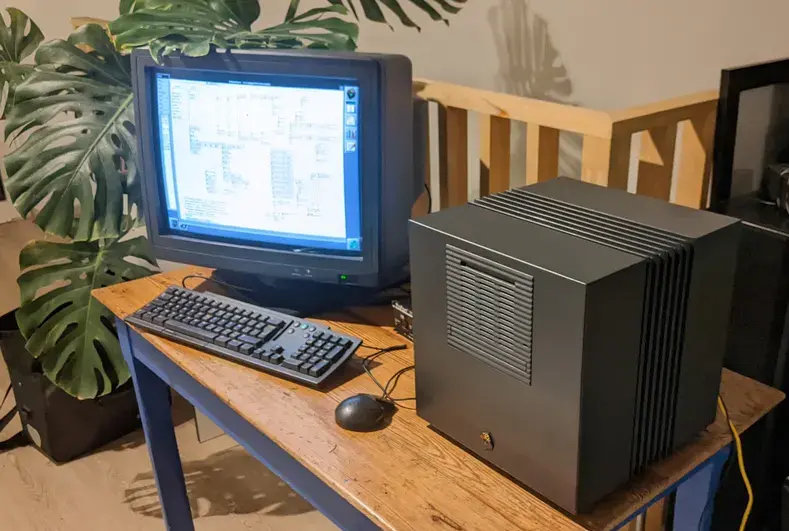
IPEM's NeXTcube with IRCAM Ariel ProPort.
There were a few practical issues: the mouse was broken, the hard drive unreliable and the main system fan loud and full of dust. The mouse had a broken cable which was fixed, the hard drive was replaced by a SCSI2SD setup and the fan was replaced with a new one. On the software side of things, the Internet Archive hosts NeXTStep 3.3 which, after many attempts, was installed on the cube. Unfortunately there seemed to be a compatibility issue. The Ariel ProPort kernel module did not work. I started over installed NeXTStep 3.1, with the same result. Finally, I installed NeXTStep 3.0 which was compatible with the kernel module and MAX/FTS!
Vid: Max/FTS with a commercial Ariel soundcard running on a NeXTcube Turbo.
The restoration of the IRCAM Signal Processing Workstation instruments fits in a university project on living heritage The idea is to get key historic electronic music instruments into the hands of researchers and artists to pull the fading knowledge on these devices back into a living culture of interaction. This idea already resulted in an album: DEEWEE Sessions vol. 01. Currently the collection includes a 1960s reverb plate, an EMS Synti 100 analog synthesizer from the 70s, a Yamaha DX7 (80s) and finally the NeXTCube/ISPW represents the early 90s and the departure of physical instruments to immaterial software based systems.
Acknowledgements & Further reading
This project was made possible with the support of the Belgian Music Instrument Museum and IPEM, Ghent University. I was fortunate to get assistance by Ivan Schepers and Marc Leman at IPEM but also by the main developers of MAX: Miller Puckette. I would also like to thank Anthony Agnello formerly at Ariel Corp for additional image material and info. I also found the WinWorld and NeXTComputers communities and resources extremely helpful. Thanks a lot!
See also the discussion on this article at Hacker News\
Lindemann, E., Dechelle, F., Smith, B., & Starkier, M. (1991). The Architecture of the IRCAM Musical Workstation - Computer Music Journal, 15(3), 41–49.
\
Puckette, M. (1991). FTS: A Real-Time Monitor for Multiprocessor Music Synthesis. Computer Music Journal, 15(3), 58–67.
\
Puckette, M. 1988. The Patcher, Proceedings, ICMC. San Francisco: International Computer Music Association, pp. 420-429.
\
Puckette, M. 1991. Combining Event and Signal Processing in the MAX Graphical Programming Environment. Computer Music Journal 15(3): 68-77.\
